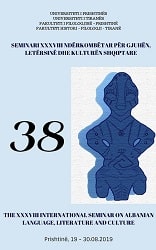Ëndrra në eposin e Kreshnikëve në suazën e eposeve të tjera mesjetare e paramesjetare
Dream in the Epic of the Knights Templar in the Context of Other Medieval and Pre-medieval Epics
Author(s): Drita IsufajSubject(s): Cultural history, Fiction, Middle Ages, Cognitive Psychology, Psychoanalysis, Theory of Literature
Published by: Univeristeti i Prishtinës, Fakulteti i Filologjisë
Keywords: dream; epic; Roland's Song; Cid's Song; Epic of Kreshniks; homeric poems;
Summary/Abstract: The motive of the warning dream is one of the most widespread and one of the oldest in the epic gender. In epic dreams appear at the key moments of the narrative as a prediction or interpretation of what is to come. They usually contain a series of symbols that have to be interpreted by the dreamer. In epic creations, dreams have a significant influence on the course of the story. In most cases they encourage the heroes to continue their journey. We encounter the warning dream in the earliest literary work found until today, the Epic of Gilgamesh. Also in both Homeric poems, Iliad and Odyssey, the motive of the dream is widely encountered. This motif appears densely also in our epic, we remember here the dream of Muji in the song "Rapture of Muj's wife", his next dream in the rhapsody "Gjogu i Mujit", the dream of Krajl's wife in "Halil's Marriage" warning of kidnapping of Tanusha. Among the medieval European epics, we mention the prophetic dream of Cid, the Spanish epic hero. He dreams about the archangel Gabriel, who tells him that he will eventually triumph. Encouraged by this dream, Cid enters the city of Toledo. In the French epic, the dream of Charlemagne is evident; the king sees two dreams that warn of misfortune; the first dream predicts Ganelon's betrayal, and the second the death of his nephew Roland. The purpose of this paper will be to examine the motive of the dream in the Epic of the Kreshniks by considering it as part of the cadre of the medieval and pre-medieval epics.
Journal: Seminari Ndërkombëtar për Gjuhën, Letërsinë dhe Kulturën Shqiptare
- Issue Year: 2019
- Issue No: 38.2
- Page Range: 37-49
- Page Count: 13
- Language: Albanian

